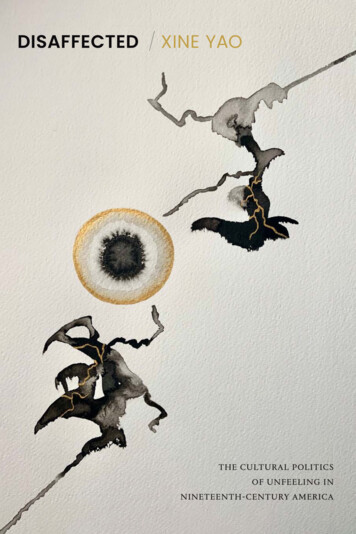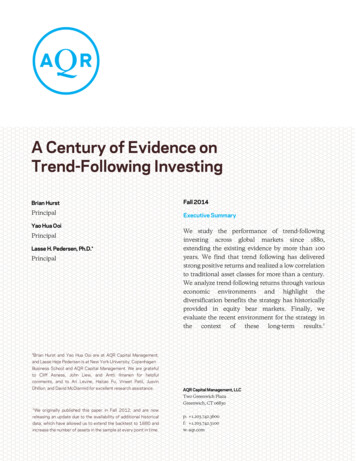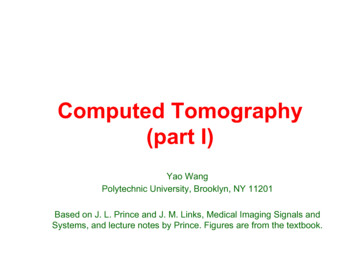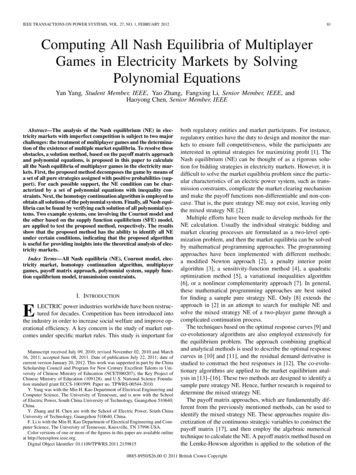
Transcription
DISAFFECTED / XINE YAOThe Cultural Politicsof Unfeeling inNineteenth-Century America
DISAFFECTED
PERVERSE MODERNITIESA SERIES EDITED BY JACK HALBERSTAM AND LISA LOWE
DISAFFECTEDXINE YAOthe cultural politics of unfeeling innineteenth- century americaDUKE UNIVERSITY PRESS · DURHAM AND LONDON · 2021
2021 Duke University PressAll rights reservedPrinted in the United States of Amer i ca on acid- free paper Designed by Aimee C. HarrisonTypeset in Portrait by Westchester Publishing Ser vicesLibrary of Congress Cataloging- in- Publication DataNames: Yao, Xine, [date] author.Title: Disaffected : the cultural politics of unfeeling in nineteenthcentury America / Xine Yao.Other titles: Perverse modernities.Description: Durham : Duke University Press, 2021. Series: Perversemodernities Includes bibliographical references and index.Identifiers: lccn 2021002641 (print)lccn 2021002642 (ebook)isbn 9781478013891 (hardcover)isbn 9781478014836 (paperback)isbn 9781478022107 (ebook)Subjects: lcsh: American literature—19th century—History andcriticism. Literature and society—United States—History—19th century. Race in literature. Affect (Psychology) in literature. Stereotypes (Social psychology) in literature. Sentimentalism inliterature. Emotions in literature. African Americans in literature. Asians in literature. bisac: social science / Ethnic Studies /General literary criticism / American / GeneralClassification: lcc ps217.r28 y36 2021 (print) lcc ps217.r28(ebook) ddc 810.9/353—dc23lc record available at https://lccn.loc.gov/2021002641lc ebook record available at https://lccn.loc.gov/2021002642Cover art: Lucia Lorenzi, icarus, 2020. Carbon black pigment ink,gouache, and watercolor, 10 14 inches. Courtesy of the artist.Publication of this book is supported by Duke University Press’sScholars of Color First Book Fund.
CONTENTSAcknowl edgments / viiintroduction /1 the babo prob lem / 291Disaffected from theCulture of SentimentWhite Sentimentalism andUnsympathetic Blackness inHerman Melville’s Benito Cereno2 feeling other wise / 703 the queer frigidityMartin R. Delany, Black- IndigenousCounterintimacies, and thePossibility of a New World4 objectivepassionlessness /of professionalism /White Women Doctors, the Strug glefor Rights, and the Marriage Plot5 oriental138Black Women Doctorsand Dispassionate Strategiesof Uplifting Loveinscrutability /171Sui Sin Far, Chinese Faces,and the Modern Apparatusesof U.S. Immigrationcoda /208Notes toward a DisaffectedManifesto beyond SurvivalNotes / 211Bibliography / 243Index / 269107
ACKNOWL EDGMENTSOne of the most fundamental conditions of possibility for finishing this book— a condition that too often remains unmentioned— was staying alive. So I acknowledge this as a starting point to indicate how inadequate my acknowl edgments are: despite my best efforts, this citational practice will always be apartial recognition of the messy convergences of intimacies and counterintimacies that have produced, challenged, enabled, beleaguered, and nourished ill have to imagine for yourself the no- less- necessary detachmentsme. You win apposition to these attachments and in opposition to certain intimacies.The Yao family: Mom, Dad, Cathee, and our beloved felines. My dear auntTeresa, as well as Uncle and Auntie Dodo. I miss my grandparents (Brian andMamie Yu and Annie Yao) still.My uneven personal trajectory that has gone into this book has beenvariously situated on the lands of the Haudensaunee, Mi’kmaq, Cayuga, andMusqueam peoples— and came to close as I am now located in the formerheart of empire. Funding that made this work pos si ble came from the SocialSciences and Humanities Research Council of Canada; an Andrew W. Mellon Foundation Fellowship with the Library Com pany of Philadelphia andthe Historical Society of Pennsylvania; the Frances Clark Wood Institute forthe History of Medicine; and many funding sources at Cornell University, including several Humanities Dissertation Writing Group grants from the Society for the Humanities, Interdisciplinary Reading Group Grants from theInstitute for Comparative Modernities, the M. H. Abrams Summer Gradu ate Fellowship, and the American Studies Program at Cornell for archivalvisits to the Historical Library of the College of Physicians in Philadelphia,the Mas sa chu setts Historical Society, and the American Antiquarian Society.Many thanks to my committee members, Eric Cheyfitz, George Hutchinson, and Shelley Wong, and special appreciation for my supervisor ShirleySamuels, who supported me as a scholar and a person. Shirley encouraged her
students to create lateral networks of support: many thanks to the Americanist Reading Group, especially Brigitte Fielder, Jonathan Senchyne, and JesseGoldberg. Thank you to my postdoc supervisor, Mary Chapman, for continuing this feminist scholarly mentoring practice, and to Shawkat Toorawa,who treated me like a colleague as soon as I stepped on campus.The First Book Institute provided an invaluable opportunity: thank youto Sean X. Goudie, Priscilla Wald, and the institute staff for maintainingthis resource for early- career scholars. I am grateful to my fellow participants, in par tic u lar Katie Walkiewicz, Sunny Xiang, Chris Perreira, and BenBascom. Previous iterations of this work have benefited from my modera utures of Americantors, fellow panelists, and audiences at meetings of the FStudies Institute, the Modern Language Association, the American StudiesAssociation, C19: The Society of Nineteenth- Century Americanists, the British Association of American Studies, the Max Planck Institute for HumanDevelopment, the Critical Ethnic Studies Association, the American Lit er a ture Association, the Association of Canadian College and UniversityTeachers of En glish, the American Comparative Lit er a ture Association, andthe Association for Asian American Studies. There have been many keen andgenerous eyes on my work to my benefit over the years, such as Ana Schwartz’sand T. J. Tallie’s.To my PhDivas cohost, Liz Wayne, thanks for camaraderie and careacross the stem/humanities divide. There are too many people in my communities routed through Cornell for me to thank; it broke my heart to leaveand to know we would never reassemble in the same configurations again.Gratitude to my Vancouver circles— particularly members of the queer, fem eople of Color) circles, includinginist, and bipoc (Black, Indigenous, and PKiran Sunar, Kristi Carey, Aidan Davis, Corey Liu, Kavelina Torres, KatrinaSellinger, Lucia Lorenzi, Hannah McGregor, and Fern Ramoutar. In LondonI was sustained by many relationships with new friends: thank you in par tic u lar to Ifeanyi Awachie, Jade Bentil, Ama Bud ge, Emily Floyd, Lo Marshall,and Rianna Walcott. Much gratitude to Christine Okoth, for the insightsthat helped me through the penultimate stage of the manuscript pro cessduring the COVID-19 lockdown. Credit to Steve Morrison for supporting meas I stumbled across the final stretch. Thanks also to certain unnamed digitalspaces, for those everyday lateral minoritarian intimacies.On April 10, 2020, during the first COVID-19 lockdown, Lucia shared onInstagram the third in her ink painting series “About Touch and Intimacyduring the Pandemic.” In the caption, she remarked, “Not sure how to resolve the piece yet, so I’m stepping away from it, turning it around, seeingviii ·Acknowl edgments
what works so far.” A continent and an ocean away, I was mesmerized by hercreative rendition of the paradoxes of intimacy and distance that spoke to mywork as I strug gled to finish it. Thank you, friend, for generously sharing yourgorgeous artwork with me. To me, this collaboration of sorts captures something of the queer of color ethos, femme survival, and Black- Asian counterintimacies that informs the feeling other wises of Disaffected.Working with Duke University Press has been a plea sure. Courtney Bergerand Sandra Korn have been patient and supportive; the many other staffmembers have been incredibly helpful during this process— which I understand is intense at the best of times, and even more so during the pandemic.The rigorous scrutiny of the copyeditors has greatly contributed to the polishof the words you see before you.Any failings are mine alone; in admitting my fallibility, I hope for your patience, for all I can promise is my continued commitment to try to do rightby others. I humbly request your reciprocity in this mutual, uneven pro cessof knowledge- making, meaning- making, and community- building.In my experience it is no contradiction that the entanglements of certaindefiant, weary expressions of refusals to care can be transformed into collective care. To you and to so many others: thank you for keeping me alive.Acknowl edgments· ix
INTRODUCTION /Disaffected from the Culture of Sentimentaffectability: The condition of being subjected to both natu ral (in the scientificand lay sense) conditions and to others’ poweraffectable “I”: The scientific construction of non- European minds— Denise Ferreira da Silva, Toward a Global Idea of RaceBy disaffection, I emphasize not only emotional distance, alienation, antipathy,and isolation but also to center this word’s other connotation of disloyalty toregimes of power.— Martin F. Manalansan IV, “Servicing the World: Flexible Filipinos and the Unsecured Life”I thus am able to conceive of the opacity of the other for me, without reproachfor my opacity to him. To feel in solidarity with him or to build with him or tolike what he does, it is not necessary for me to grasp him.— Édouard Glissant,Poetics of Relationwhite feelings, white tears, white fragility, white women’s tears, whitemen’s tears: these phrases circulate within popu lar antiracist social justicediscourse galvanized by the Black Lives Matter movement. These phrasesarticulate frustration with the ongoing manifestations of what scholars have
variously called the “unfinished business of sentimentality,” the legacies ofthe “intimacies of four continents,” and “the biopolitics of feeling.”1 Theyname the weaponization of white feelings in everyday life.2 Behind these usesis the implicit statement: we know— indeed, have always known— that whitefeelings produce and maintain structures of domination.3 To depend uponwhite feelings as the catalyst for social change reinscribes the world thatenables their power. No more business with white sentimentality. Withholdfrom those colonial intimacies. Refuse to feel according to the hierarchies ofthe biopolitics of feeling. Be disaffected. There is ambivalence. There is discontent. Perhaps one of the more radical manifestations of this critical dissatisfaction can be seen in a 2017 polemic by the writer and popu lar social media critic Robert Jones Jr., knownas Son of Baldwin, who writes from a Black queer perspective. The essay“I Don’t Give a Fuck about Justine Damond” responds to the killing of an oman by a Black police officer by breaking downunarmed white American wthe dynamics of racialized sympathy and emotional labor tied to legacies ofBlack enslavement: eople rely on this idea that black p eople, in situations whereMost white pwhite people are in pain, are only ever to be soothing and understanding; ncle Remus; only ever to extend condolences;only ever to be Mammy or Uonly ever to embody loyalty; only ever to offer the empathy and sympathythat most white people purposely and haughtily deny when the situationis reversed — almost as if most white people still see us as their property.When the situation is reversed, when we require empathy and sympa e’re all of the opposite t hings that these once- needythy, then suddenly wwhite people previously said we were. When the shoe is on the other foot,then they assess us as immoral, violent, criminal, subhuman, unworthy.4Black and Indigenous w omen who are victims of police brutality, as Sonof Baldwin points out, do not receive the same sympathy. So, writing severalyears after the emergence of the Black Lives M atter movement, he choosesto be unsympathetic about the death of Justine Damond despite the angerhe knows his stance will provoke. “My disinterest is white people’s fault,” hedeclares.5 In a follow-up post, he asserts that he is unmoved by the backlashhe has received from enraged white readers withdrawing their allyship to thosehe calls the “black/brown domestics,” insisting on the importance of whitefeelings.6 “Sentimentality, the ostentatious parading of excessive and spuriousemotion,” accused James Baldwin in his indictment of Harriet Beecher Stowe’sparadigmatic protest novel Uncle Tom’s Cabin (1852), “is the mark of dishonesty,2 ·Introduction
the inability to feel; the wet eyes of the sentimentalist betray his aversion toexperience, his fear of life, his arid heart; and it is always, therefore, the signalof secret and violent inhumanity, the mask of cruelty.”7 Referring to his “heartalready full to capacity for all the dead black p eople killed by police,” Son ofBaldwin develops the antisocial affective implications of his namesake’s critique. “I’m very much onto something with black apathy as radical oppositionto their toxic ecol ogy. And I believe it may be a key to liberation,” he concludes.8The vio lence of white tears described by James Baldwin becomes projectedonto those who refuse to be moved by them and are condemned as the onesunable to feel, with arid hearts, secret and violent inhumanity. Nonetheless,Son of Baldwin rejects that unspoken social contract of sympathy— for theseunfeeling vilifications are already built into the structures of the United Statespredicated upon Black enslavement and Indigenous dispossession.9Disaffected looks to American lit er a ture of the long nineteenth c entury torethink the ongoing racial and sexual politics of unfeeling not as oppressionfrom above but as a tactic from below. This book deliberately reads against thegrain of the culture of sentiment to refuse the usual move of arguing for thehumanity of minoritized subjects by enlisting lit er a ture to affirm that they feeltoo. Disaffected asks what we can apprehend if we stay with the negativity ofunfeeling and suspend its rehabilitation. Through this provocation, I seek toexcavate unfeeling occluded by the stifling imperatives of the po liti cal stakesof sympathy. In her preface to Incidents in the Life of a Slave Girl (1861), HarrietJacobs signals her ambivalence about the po liti cal necessity of writing aboutherself as a formerly enslaved Black woman who is keenly aware of the stakesof her reworking of the genre of the slave narrative and the conventions of sentimentalism: “I have not written my experiences in order to attract attentionto myself; on the contrary, it would have been more pleasant to me to havebeen silent about my own history. Neither do I care to excite sympathy for myown sufferings. But I do earnestly desire to arouse the women of the North toa realizing sense of the condition of two millions of women at the South, stillin bondage, suffering what I suffered, and most of them far worse.”10Jacobs alludes to the compromises behind the cultural equation betweentrue feeling and right action exemplified by Uncle Tom’s Cabin that continuesto overdetermine the politics of recognition under lying cultural fantasies ofjustice and social change. “ There is one thing that every individual can do,— they can see to it that they feel right. An atmosphere of sympathetic influenceencircles every human being; and the man or woman who feels strongly, healthily and justly, on the g reat interests of humanity, is a constant benefactor tothe human race,” concludes Stowe.11 Her call to humanity for the correctiveIntroduction· 3
of universal sympathy collapses naturalized, individual affective capacitieswith impersonal, collective affective intensities. Jacobs was spurred to publish her own abolitionist narrative after the humiliation of reaching out toStowe with her life’s story and requesting the opportunity for her daughterto travel with the famous writer to England— only to have Stowe reject thepossibility of writerly collaboration; turn down her d aughter; and insteadexpress her intention to appropriate Jacobs’s experiences as material for hernew book, The Key to Uncle Tom’s Cabin (1853).12Obscured in Stowe’s injunction to “feel right” is the structural positioningof those privileged to be hailed as “ every individual,” “ every human being,”or “man or woman” with the authority to translate that sympathetic identification into action for “the human race.” For them to be unsympathetic isa choice: their moral failure is an aberration that does not compromise theirpresumed status as subjects. This schema conceals the grounds for the politics that determine the recognition of the subjugated, a disciplinary apparatusthat governs the terms of sociality: one must be recognized as sympathetic tobe deserving of sympathy from t hose with the agency to sympathize. Thus,the marginalized do not have the luxury of being unsympathetic withoutforfeiting the provisional ac cep tance of their capacity for affective expressions and, therefore, the conditional ac cep tance of their humanity.Disaffection / Reframing Recursive Debatesabout Sympathy and SentimentalismThe phi los o phers Sylvia Wynter and Denise Ferreira da Silva have arguedthat the category of “Man,” referring to bourgeois Western whiteness, overrepresents itself as universal humanity structured upon the suppression of uman as mere derivations.13 If we follow linesracialized modalities of the hof inquiry opened up for us by their insights, what operations w ill we findconcealed and enabled by the construct of universal feeling as a symptomand signifier of that coloniality? Affectability, according to da Silva in herstudy of Enlightenment universality transmuted into the biopo liti cal apparatuses of global modernity, is “the condition of being subjected to bothnatu ral (in the scientific and lay sense) conditions and to other’s power.”14Affectability defines raciality: the “transparent I” has the agency to knowand affect, while the “affectable I” is the susceptible, the “scientific construction of non- European minds.” In this way da Silva recalls for us Baruch Spinoza’s foundational proposition about the nature of the emotions in relationto the world. Spinoza states, “By emotion I understand the modifications4 ·Introduction
of the body by which the power of the acting of the body itself is increased,diminished, helped, or hindered, together with the ideas of t hese modifications.”15 Although not written with affect studies in mind, da Silva’s definition of affectability, as Tyrone Palmer observes, points to “the inextricabilityof ‘affect’ from power.”16 Disaffection, then, threatens a break from affectability.In Stowe’s Key to Uncle Tom’s Cabin, the supplementary text documentingthe “truth” of her novel’s depiction of slavery in response to the outcry fromproslavery apologists, she divulges the racialized hierarchy of the transparent and the affectable that produces the universal. The “Anglo- Saxon race,”asserts the white abolitionist, is “cool, logical, and practical,” with an obligation to sympathize given its “dominant position in the earth.”17 In contrast,she places “the negro race” u nder the umbrella of “Oriental nations” to articulate “a peculiarity which goes far to show how very dif fer ent they are fromthe white race”: “They are possessed of a ner vous organ ization peculiarlysusceptible and impressible. Their sensations and impressions are very vivid,and their fancy and imagination lively. In this re spect the race has an Oriental character and betrays its tropical origin. Like the Hebrews of old and theOriental nations of the pre sent, they give vent to their emotions with theutmost vivacity of expression, and their w hole bodily system sympathizes18with movements of their minds.” Here we can observe how da Silva’s affectability maps onto what Mel Chenterms the animacy hierarchy, which encompasses the spectrum of the humanand nonhuman, the organic and the inorganic, the living and the nonliving.19According to Stowe’s enduring sentimental model of justice, racialized peoplesare legible only through their affectability. Emotional expression is presumedto be the signifier of affective human interiority, what Rei Terada calls the“expressive hypothesis.”20 If they do not accept this condition of affectablevulnerability, they fail to demonstrate their emotions as evidence of their sub uman subjects. The coloniality of this bindjectivity and, therefore, status as hmeans that this pro cess is always precariously iterative, contingent upon recognition by those already overrepresented as the universal human. Sympathyis “one of the fundamental ethical questions/problems/crises for the West,”Saidiya Hartman observes in conversation with Frank B. Wilderson III, “It’s asthough in order to come to any recognition of common humanity, the othermust be assimilated, meaning in this case, utterly displaced and effaced.”21I ask, then, how does unfeeling operate as the constitutive outside to thattotalizing system, and what challenge can disaffection pose? In this regard,I take unfeeling not simply as negative feelings or the absence of feelings,but as that which cannot be recognized as feeling— the negation of feelingIntroduction· 5
itself. By foregrounding the heuristic of unfeeling as disaffection in its affective, causal, and po liti cal meanings, this book makes key interventions in ourunderstanding of affect and politics in American lit er a ture and culture, a paradigm that has disproportionately affected the world. First, I reconsider unfeeling as an index of the underacknowledged spectrum of dissonance and dissentthat critiques the demands of sympathetic recognition s haped by sentimentalism, questioning the liberal proj ect of inclusion. Second, I explore unfeeling, in both the responsive and demonstrative senses, as a quotidian tactic ofsurvival and a counterintuitive, and sometimes counteractive, mode of care.Fi nally, I propose that these antisocial affects are vilified as unfeeling becausethey have insurgent potential that may not be legible or instrumentalized toward re sis tance. If we follow Raymond Williams’s definition of structuresof feeling as the affective workings of ideology in lived experience, we mayconsider disaffection to be the unfeeling rupture that enables new structuresof feeling to arise.22 In other words, the reading of unfeeling as oppositionalnegation functions as a defensive denial of the quickening, flourishing, andrenewal of alternative forms of sociality made pos si ble by feeling other wise.In this book I trace a representative array of queer, racialized, and genderedmodes of disaffected unfeeling that emerges within dominating structures offeeling from a range of precarious positions within the axes of oppressionthat constitute the biopo liti cal hierarchy. These groupings— unsympatheticBlackness, queer frigidity, Black objective passionlessness, and Orientalinscrutability— are not meant to be taxonomic or exclusionary, but to articulate a few key coded categories in the cultural imagination deployed to flattenout and invalidate individual and collective subtleties.23 These nascent, fleeting, and sometimes failed modes of affective disobedience capture transgressive desires, ambivalences about relationality, and complicated investmentsthat cannot be readily redeemed into the trajectory of liberal politics— andmay even be damaging and countereffective.In this contrarian manner, I read Herman Melville’s Benito Cereno (1855),Martin R. Delany’s Blake; or the Huts of Amer i ca (1861), Elizabeth Stuart Phelps’sDoctor Zay (1882), Frances Ellen Watkins Harper’s Iola Leroy (1892), andMrs. Spring Fragrance (1912) by Sui Sin Far (the pen name of Edith MaudeEaton). These narratives published after Stowe’s novel engage the major sociopo liti cal issues of their day in ways that question the coercive relationship between Stowe’s paradigmatic model of right feeling and po liti cal pro gress. Idiscuss these literary works in the explicit and implicit contexts of the strug gles toward fantasies of justice linked to the Fugitive Slave Act of 1850; the Fourteenth and Fifteenth Amendments to the Constitution on Black citizen6 ·Introduction
ship and Black men’s suffrage, respectively; Black and white women’s rightsactivism toward suffrage that would be addressed by the Nineteenth Amendment; and the Chinese Exclusion Act of 1882.24 I explain how t hese texts register ambivalence t oward the very demand for sympathetic recognition— which, as Glen Coulthard (Yellowknives Dene) argues in his indictment of thepro cesses of reconciliation for Indigenous peoples in Canada, is colonial and hese writers strategically employ the conventions of sentimentalcoercive.25 Tism but then portray disaffected characters whose obdurate composure anddivisive actions defy the expectations of right feeling that structure the politics of recognition. Rather than simply refuting negative portrayals of unfeeling contoured by racial and sexual politics, they reappropriate this apparentemotional lack as the affective symptom of dissatisfaction in ways mindfulof the uneven po liti cal stakes and punishments risked by dif fer ent subjects. Ishow how lit er a ture disrupts reading practices that crave affective access, legibility, and affectability. I thus bring into relief the complex and dynamic waysthat minoritized subjects s haped the cultural, po liti cal, and even professionaldiscursive arenas where these strug gles took place, including the developingfield of gynecol ogy and the conflict between monogenesis and polygenesistheories of human development in race science.I am not so much interested in fine- tuning the distinctions between agenticvolition and instinctual physiology that attend the generally held taxonomization of the strata of affect, feeling, and emotional expression— ordered alongthe polarization of the axes of interiority to externalization and unconsciousto conscious—as I am in stressing the flexible operations of how t hese differentiations naturalize scales of the human, nonhuman, living, and nonliving thatChen groups under the rubric of the animacy hierarchy.26 Of greater concernto me are the operations of unfeeling as a form of antisocial discontent about,if not outright defiance of, the compulsory norms for expressing feeling alongwith susceptibility to the feelings of others. Unfeeling can signal skepticismand reluctance to signify the appropriate expressions of affect that are sociallylegible as human, which can rise to the refusal to care and sympathize as partof the expected cues of deference that maintain and structure biopo liti cal hierarchies of oppression. Lauren Berlant points out that withholding can operate as a sign of civility for the privileged and is “often deemed good mannersin the servant class,” and for t hose so- called “prob lem populations,” such disaffection signals the threat of the ungovernable.27 The popu lar understandingof emotional labor, a term originally coined by the sociologist Arlie Hochschild, is a useful way to address the uneven expectations about who does this labor and for whom according to the overlapping but irreducible pro cesses ofIntroduction· 7
racialization, class differentiation, and their modulations of sexual differencethat persist despite the promise of socioeconomic mobility.28 In this light, theliterary works I discuss explore pathologized models of affective disobedienceand agency that defy and rework scientific and l egal discourses naturalized bythe culture of sentiment. Through tactical shifts in mood, voice, and perspective, they offer glimpses into how accusations of unfeeling mask the transgressive validity, lived necessity, and emerging possibilities of antisocial affectsand gestures that may be counterproductive to the conventional demands ofadvocacy. These writings demonstrate the inextricable relationship betweenthe everyday and formal, institutional scales of the politics of sympathetic recognition that make up the governmentality of sentimentalism.I linger with unfeeling, rather than dismissing or exonerating it. By focusing on unfeeling as disruptive negation, I aim to introduce a way of reframingthe perennial Americanist fixation with oscillating between the structuralcomplicity of sentimentalism or the feminist recuperation of its po liti cal andcultural work that goes back to Ann Douglas’s and Jane Tompkins’s generative disagreements about Uncle Tom’s Cabin de cades ago.29 Sentimentalism remains an enduring— though often disavowed— rhe toric, genre, cultural mode,set of material relations, ideology, and episteme. Our understanding of sentimentalism has expanded to take seriously its essential part in the coerciveAmerican national proj ect of citizenship and belonging, as shown through thework of Berlant and Pier Gabrielle Foreman.30 It plays this part as an ethicallyfraught po liti cal tool for abolitionist and feminist agendas.31 It is genderednot only as feminine and domestic, but also as impor tant to the redefinitionof consolidated masculinity in the private and public spheres.32 In addition,its materiality informs embodiment and even the development of consumermaterialism.33 And most importantly, its constitutive racialized and colonialvio lences are complex.34 It infiltrates even institutional bastions consideredthe obverse of sentimental: Kyla Schuller insightfully draws attention to itsoperation as a technology of scientific biopower, which she calls the biopolitics of feeling.35 But if, as Shirley Samuels writes, sentiment is at the heart ofnineteenth- century American culture, what does it mean to withdraw fromthat totalizing em
Kiran Sunar, Kristi Carey, Aidan Davis, Corey Liu, Kavelina Torres, Katrina Sellinger, Lucia Lorenzi, Hannah McGregor, and Fern Ramoutar. In London I was sustained by many relationships with new friends: thank you in par tic-ular to Ifeanyi Awachie, Jade Bentil,










